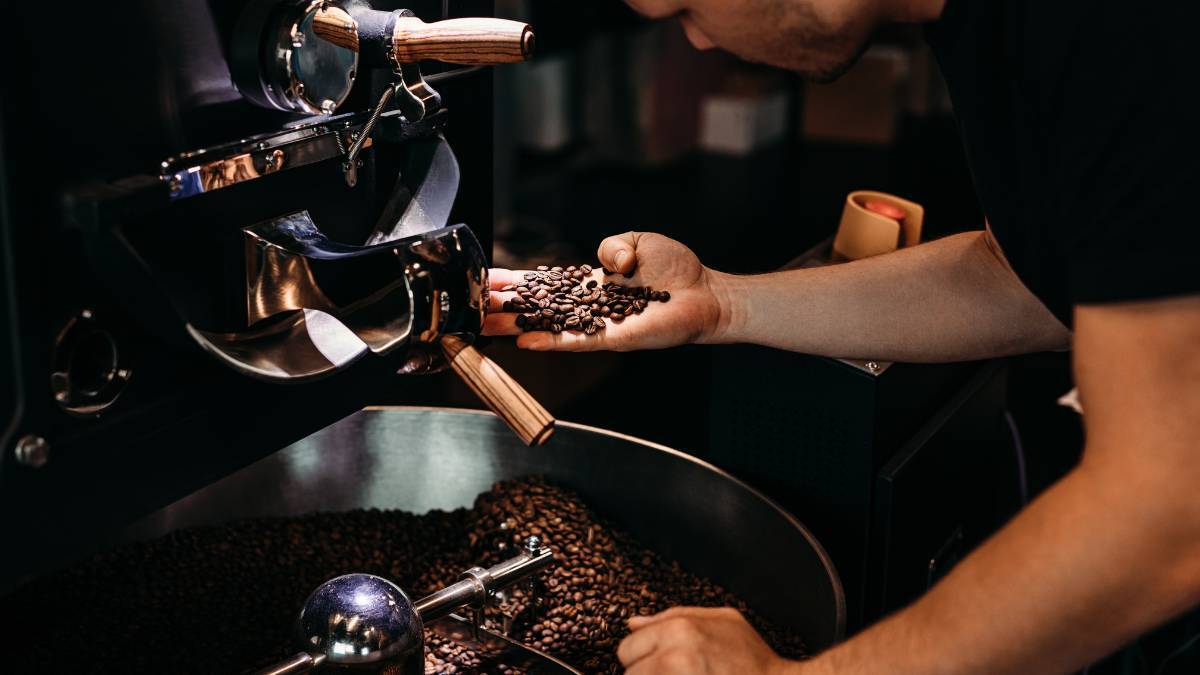
Every coffee bean holds a world of potential flavor, but it's the roasting process that unlocks it. Roasting is a craft where science and sensory skill combine to transform dense, green, and grassy-smelling beans into the wonderfully aromatic, brittle, and flavorful coffee we cherish. Understanding this magical transformation is key to appreciating every sip.
Whether you roast at home or buy from a specialty roaster, this guide will walk you through the essential stages of the coffee roasting process and help you navigate the different roast levels to find the perfect coffee for your palate.
The 6 Key Stages of the Coffee Roasting Process
A coffee roaster is a controlled environment where green coffee beans are tumbled and heated. While the process is continuous, it can be broken down into six distinct phases.
1. The Drying & Yellowing Phase
Green coffee beans are loaded into a preheated roaster drum. For the first several minutes, the beans absorb heat and their internal moisture begins to evaporate, causing them to release a steamy, grassy aroma. As they dry, their color transitions from a vibrant green to a pale yellow.
2. The Browning Phase (Maillard Reaction)
Once the moisture has been reduced, the Maillard reaction begins. This is the same chemical reaction responsible for the browning of toast or the searing of a steak. Natural sugars and amino acids within the beans react, creating hundreds of new aromatic and flavor compounds. The beans turn a light cinnamon-brown color during this stage.
3. The First Crack
As internal pressure from steam and carbon dioxide builds inside the beans, they begin to audibly crack or pop, similar to the sound of popcorn. This "first crack" is a critical milestone. At this point, the beans have expanded in size, and the roast is officially considered "light." The sugars are beginning to caramelize, and the coffee is now brewable.
4. The Roast Development Phase
The time between the first and second crack is where the roaster's skill truly shines. During this phase, the roaster carefully manipulates heat to develop specific flavors. Acidity begins to mellow while body increases. The beans continue to darken, and oils start to migrate from the core to the surface.
5. The Second Crack
If the roast continues, the beans will begin a second, quieter crack. This sound is more of a crispy snap, caused by the internal structure of the bean fracturing. Roasts taken to or beyond this point are considered "dark." Much of the coffee's original character is replaced by smoky, roasty flavors, and the beans will have a visible oily sheen.
6. Cooling & Degassing
Once the desired roast level is achieved, the beans must be cooled rapidly to halt the roasting process instantly. They are typically dropped into a cooling tray where air is used to bring them down to room temperature. After cooling, the freshly roasted coffee releases a significant amount of carbon dioxide (CO2) for the next several days. This process, known as degassing, is crucial for developing flavor. It's best to let coffee rest for at least 12-24 hours before brewing.
A Guide to Coffee Roast Levels
Each roast level highlights different characteristics of the coffee bean. Use this chart to find the profile that best suits your taste.
| Roast Level | Common Names | Appearance | Flavor Profile |
|---|---|---|---|
| Light Roasts | Cinnamon, Half City, New England | Light brown, dry surface | Bright, acidic, floral, fruity. Retains the most origin character. Higher caffeine. |
| Medium Roasts | American, City, Breakfast | Medium brown, mostly dry | Balanced sweetness, acidity, and body. A common preference for many coffee drinkers. |
| Medium-Dark Roasts | Full City, Viennese | Rich brown, slight oily sheen | Fuller body, deeper caramel and chocolate notes, muted acidity. |
| Dark Roasts | French, Espresso, Continental | Dark brown, shiny with oil | Bold, smoky, bittersweet. Dominant roast flavor with low acidity and heavy body. |
| Very Dark Roasts | Italian, Spanish | Nearly black, very oily | Intensely smoky, carbony, or tarry notes. The origin flavor is completely gone. |
Frequently Asked Questions About Roasting Coffee
What is the 'first crack' in coffee roasting?
The first crack is an audible popping sound that occurs when enough steam and gases have built up inside the coffee beans to rupture their cell walls. It's a key indicator that the beans have reached a light roast and are now brewable.
Which coffee roast has the most caffeine?
By weight, light roast coffee has slightly more caffeine. The roasting process burns off a small amount of caffeine, but it also reduces the bean's mass. So, if you measure your coffee by scoops (volume), dark roast might have more caffeine because the beans are less dense. If you measure by weight, light roast wins.
How long should coffee rest after roasting?
Roasted coffee needs to "degas" (release built-up CO2) before brewing. For optimal flavor, it's best to let coffee rest for at least 12 to 24 hours, though many roasters recommend waiting 3 to 5 days for the flavors to fully settle and develop.
What temperature is coffee roasted at?
Coffee is typically roasted with bean temperatures reaching between 380°F and 480°F (193°C to 249°C). The exact temperature profile depends on the roaster, the beans, and the desired roast level.
Why are some coffee beans oily?
Oily beans are characteristic of dark roasts. During the roasting process, lipids (oils) inside the bean are forced to the surface. The longer and hotter the roast, the more oils will appear on the exterior of the bean.
